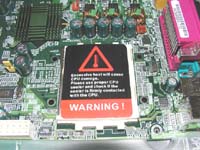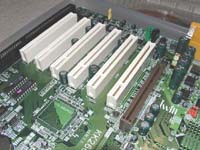 |
|
|
|
In the Forums... |
Posted: February 8, 2001 Written by: Tuan "Solace" Nguyen The KK266 Board As soon as it came into the lab, I was already impressed by the amount of care taken into making sure that the end user receives a board in perfect condition. Judging from the picture above, Iíd say itís pretty hard to lay a scratch on the board considering that Iwill places the KK266 inside a hard, protective enclosure. This is much more securing than the cheap anti-static bags that other manufacturers stuff their products into. This enclosure ensures that your board also stays straight. Iíve come across 2 perfectly usable Asus A7Vís that were bent towards the center, making it hard to insert PCI cards that fit entirely into the slots. 2 thumbs up for Iwill for making sure the userís investment, is well protected.   Profile Shots. Click for larger view. Looking at the above pictures, youíll come to appreciate the nice clean look of the KK266. Personally, I wouldnít want boards with layout designs that clearly show lack of thought. Iwill really considers all component placements, making sure to minimize the chances of them colliding with large heatsinks or cables. You wouldnít want large capacitors getting in the way of installing a brand new large copper heatsink now would you? Letís take a closer look at the board.   Socket A and Thermal Detection. Click for larger view. Above you see a view of Iwillís socket placement. Looking around the socket indicates good clearance on both the left and right sides as well as the south or north side (depending on where youíre looking from). Before you rub your hands to overclock your processor, head Iwillís warning sticker on the socket itself.   Missing RAID Option and 6 full PCI slots. Click for larger view. The photo on the left, above, shows you where your RAID processor would have been had this been the KK266-R, but alas it is not and therefore you have empty spaces where the RAID chip should be and where the 2 extra IDE channels are suppose to be. The picture on the right doesnít contain any CNR, AMR or ACR slots. Personally I donít see a need for these special slots because they require network and sound features to be added into the chipset itself ultimately restricting you from future upgrades. Iwillís choice of a legacy ISA slot enables users who have just upgraded from old systems to reuse old devices such as their 56K ISA modem. Iíd rather use an ISA modem than a PCI one anyway -- why waste a PCI slot to a modem? So far Iíve only mentioned positive things about the boardís layout but there is one thing I donít like, and thatís the proximity of the DIMM slots to the AGP slot. If you already have an AGP card inserted and want to remove or add a memory stick, the DIMM clips closest to the AGP slot have a difficult time opening if opening at all. If the slots were moved over just a bit, it would be perfect. This is a minor issue but can cause some annoyance to those upgrading and changing things on a frequent basis. |
||
|
| |||
|---|---|---|---|